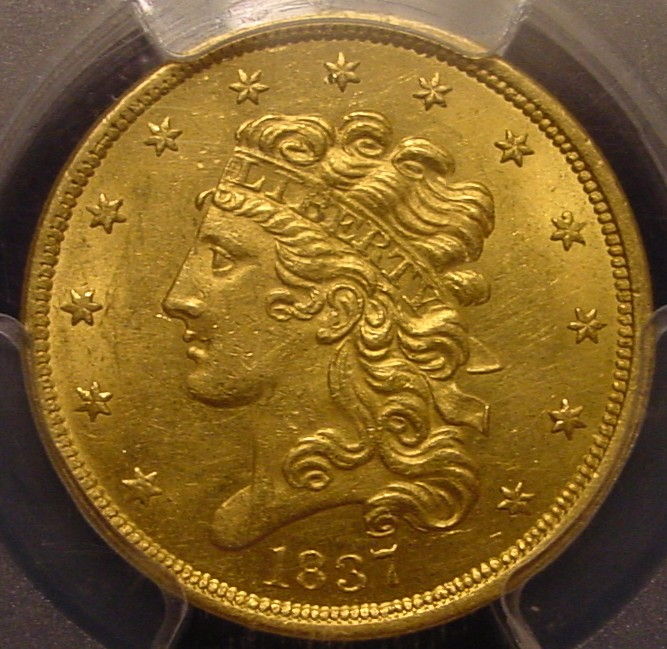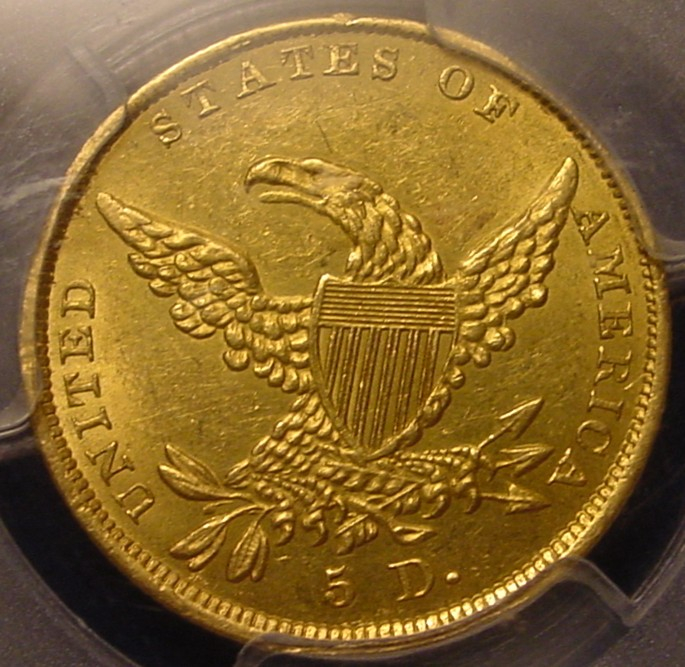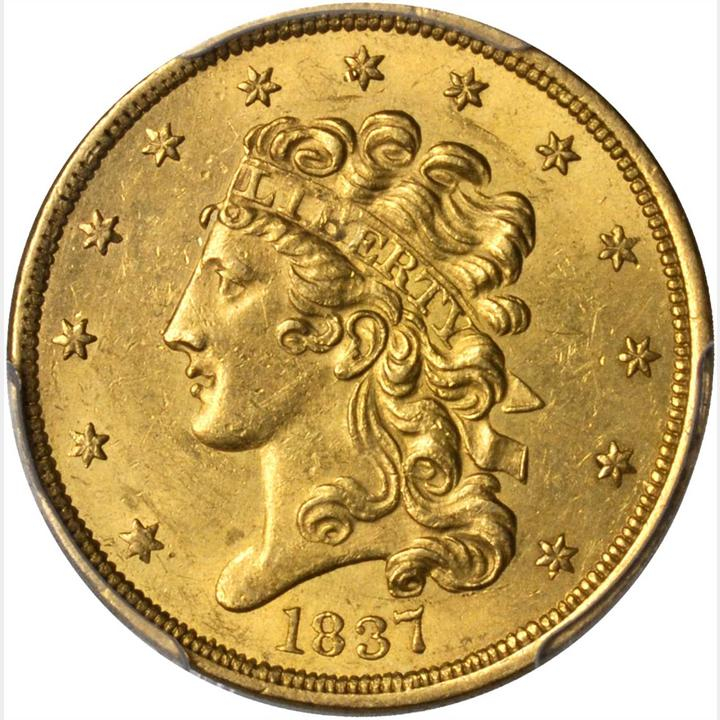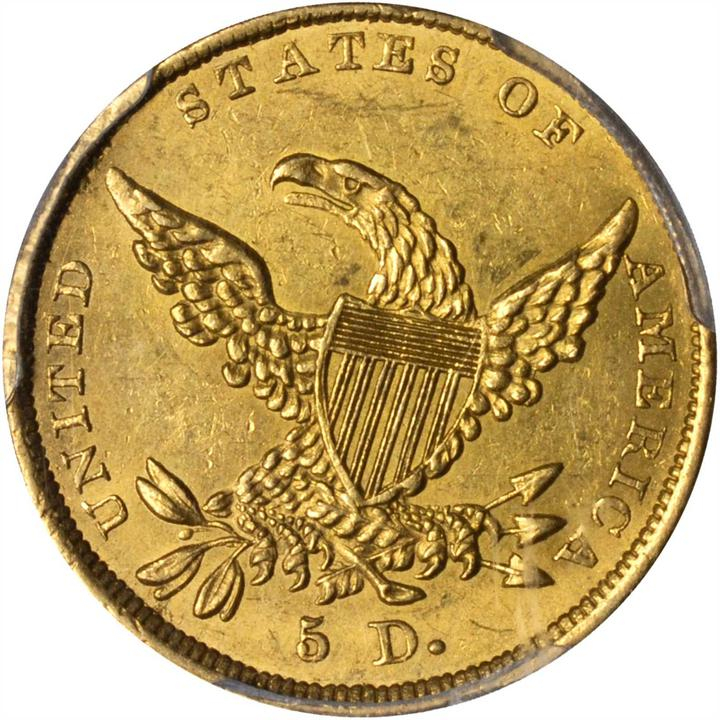Classic Head Gold Collection, Part 10, 1837 Half Eagle


Mintage 207,121
Estimated Number of Survivors 350
Like the 1837 quarter eagle, the 1837 half eagle is a deceptively scarce coin. Although the mintage was fairly substantial, the depression year conditions may have limited the number of pieces that were set aside or sent abroad for international trade purposes. Many of the coins that collectors enjoy today were exported to Europe in the 19th and early 20th centuries, spent considerable time in foreign bank vaults and have been re-patriated over the past few decades. While the relative number of Classic Head coins that were saved in this way was small in a relative sense, there certainly were a few of these pieces that have had “European vacations.”
I have been able to trace this MS-61 graded piece back the 1976 Stacks’ ANA auction. It was graded as an AU in that sale, and my grade is AU-58+. This is an example of a near Mint State coin that has been market graded to Mint State because that reflects its true value.
I purchased this piece in a Stacks' auction. Here are their photos.


Comments
Excellent quality. Is there any record of how the Americans of the 1830s regarded the design on these coins that were short lived?
I have never read any press reports that people objected to this design. I think the reason for the fast changes was because Christian Gobrecht had taken over as the Co-Chief Engraver and wanted to put his stamp on American coinage. William Kneass, who designed these coins, had a debilitating stroke in 1835, which left him paralyzed on his right side. After that he couldn’t do much, but the mint kept him on the payroll. The salary pool for the Chief Engraver’s job was split between Gobrecht and Kneass. Kneass passed on in 1840.
Great series Bill.... The old gold coins are just beautiful pieces of history. Cheers, RickO
The Classic Head gold design made two significant changes from that of the existing gold coinage. The cap was removed from Liberty's head and replaced with a cincture. The motto "E Pluribus Unum" was removed from the reverse.
There was some backlash that lasted for months in Congress and at Treasury over these design changes that took effect on August 1, 1834, It seems that the public was under the impression that these design changes were made in order to distinguish the old tenor gold coin dated 1834 from the newer coins of the same date which contained less gold, and that the design would revert in 1835 after the dates on the coins changed. This was not the case and not the reason the design on the coins changed.
Nice 1837 Bill, tough to find original and high grade. When I collected the series, bought a nice 1837 $5 PCGS AU58 from Doug Winter, enjoyed it 7 years, sold it back to Doug.
Questions for Bill or Ronyahski (or anyone who can answer):
What was the first usage of the term "old tenor gold" for early US gold before the 1834 change?
Was "cincture" a description used at the US Mint? If not, when was it first used for CHG?
I lifted "cincture" from a letter that Mint Director Samuel Moore sent to Secretary of Treasury Levi Woodbury on July 9, 1834. Moore wanted to remove the cap from the head of Liberty because he thought, as did Jefferson, that placing the Pileus or Cap of Liberty on the head of the figure represented the emancipation of slaves. Moore was defending his redesign of the gold coinage when he wrote:
"In regard to your suggestion of affixing to the gold coinage, after the 31st instant, the date of the month, to designate the new coins from others of the current year, I have respectfully to observe: that for the purpose of such designation, the Engraver has been directed to execute new Dies in which two improvements, contemplated for some years past, shall be introduced - one is, the omission of the words "E pluribus unum" on the reverse; the other is the substitution of a new head of Liberty without the dress-cap - the hair being only restrained by the cincture bearing the inscription "Liberty.""
The current definition of "cincture" may have changed somewhat since then. I think of it more as a belt or sash.
As to "old tenor gold", no idea where that came from. Good question. Should probably stop using it until your question is answered.
Thanks Ronyahski, this is excellent information from archives that gives a description for an element of the design. For ancient coinage and statuary "ampyx" describes decorative headbands, but evidently "cincture" was used at the time of the CHG design.
The "contemplated for some years past" comment certainly refers to Thomas Jefferson's earlier writing. The Pileus was used for manumission of slaves. It was also used as a symbol on Libertas, or the Goddess of Liberty, along with the "Vindicta" represented by the pole to the cap. The Liberty Pole and Cap were symbols of the American Revolution starting in 1765, and this is the meaning on early coins ("emblematic of liberty" in the Coinage Act of 1792).
The "old tenor gold" has been used for some time to describe early gold pre 1834 change, I am interested in the source if anyone knows.
To follow-up on an old discussion, I've done some preliminary digging around into the terms "old tenor gold" and "new tenor gold".
First, to dispel published accounts that these terms were used by Mint personnell back in the time, that is not true. I have never seen "old tenor" or "new tenor" used in archival documents. When pre-1834 coins were turned into the Mint to be recoined during 1834 and years forward, Mint documents almost always referred to them as coins of the "old standard". "Old tenor" was usually a term reserved to describe notes.
My premilinary digging has found the use of these terms to be fairly recent. The oldest use of "old tenor" to describe gold coins is in the New Netherlands auction of June 1957. This auction included the Eliasberg duplicates and Breen helped write the catalogue. The first use of "new tenor" that I can find is not until July 2003 in an ANR auction describing an 1834 quarter eagle. Can anybody find any earlier use of these terms?